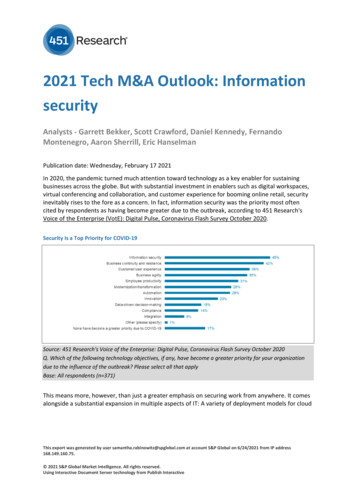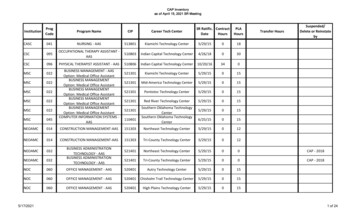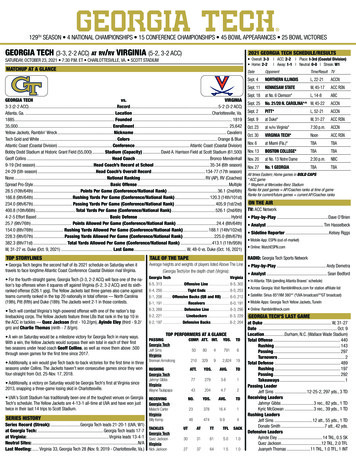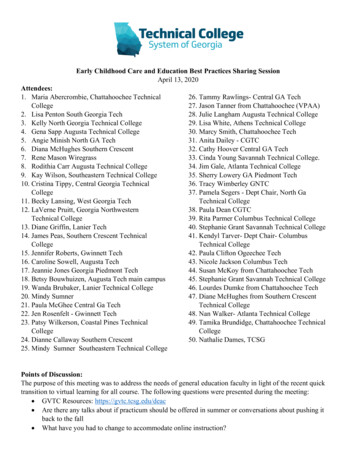
Transcription
2021 Tech M&A Outlook: InformationsecurityAnalysts - Garrett Bekker, Scott Crawford, Daniel Kennedy, FernandoMontenegro, Aaron Sherrill, Eric HanselmanPublication date: Wednesday, February 17 2021In 2020, the pandemic turned much attention toward technology as a key enabler for sustainingbusinesses across the globe. But with substantial investment in enablers such as digital workspaces,virtual conferencing and collaboration, and customer experience for booming online retail, securityinevitably rises to the fore as a concern. In fact, information security was the priority most oftencited by respondents as having become greater due to the outbreak, according to 451 Research'sVoice of the Enterprise (VotE): Digital Pulse, Coronavirus Flash Survey October 2020.Security Is a Top Priority for COVID-19Source: 451 Research's Voice of the Enterprise: Digital Pulse, Coronavirus Flash Survey October 2020Q. Which of the following technology objectives, if any, have become a greater priority for your organizationdue to the influence of the outbreak? Please select all that applyBase: All respondents (n 371)This means more, however, than just a greater emphasis on securing work from anywhere. It comesalongside a substantial expansion in multiple aspects of IT: A variety of deployment models for cloudThis export was generated by user samantha.rabinowitz@spglobal.com at account S&P Global on 6/24/2021 from IP address168.149.160.75. 2021 S&P Global Market Intelligence. All rights reserved.Using Interactive Document Server technology from Publish Interactive
2021 Tech M&A Outlook: Information securityand datacenter computing, and dramatic growth in OT and IoT rising alongside millions of newremote user endpoints, aided by developments such as 5G that have led to an explosion of theattack surface.Thus, it should come as no surprise that despite the lockdown and a predictably slow start to theyear, overall infosec M&A – as measured by deal volume – was up for the fifth straight year, to atotal of 162 transactions, handily surpassing the record total of 141 prints in 2019. In terms of dealvalue, however, the 17.9bn total fell short of the previous year's high-water mark of 23.2bn(which was inflated by Broadcom's 10.7bn purchase of Symantec's enterprise security business andThoma Bravo's 3.8bn buyout of Sophos), although there were more billion-dollar-plus cybersecuritydeals in 2020 (six) compared with 2019 (four).Infosec M&A: Cybersecurity Acquisition Volume and Spending, 2010-20Source: 451 Research's M&A KnowledgeBase, January 2021; includes disclosed and estimated valuesPrivate equity (PE) continues to expand its influence on cybersecurity M&A, with 59 PE-led deals in2020, up from 43 in 2019 and accounting for just over one-third (36%) of all cybersecuritytransactions. Five of the six billion-dollar acquisitions and seven of the top 10 were PE-led.PE M&A: Number of Sponsor-Backed Infosec Purchases, 2010-20Source: 451 Research's M&A KnowledgeBase, January 2021 2021 S&P Global Market Intelligence. All rightsreserved.Page 2 of 13
2021 Tech M&A Outlook: Information securityAs we have noted previously, with the ascendance of PE as the primary driver of cybersecurity M&Ahas come a matching decline in the volume of deals from 'traditional' security vendors. Just 41transactions (25%) came from traditional security firms in 2020, down sharply from 53 deals (38%) in2019. To some extent, this is due to the 'thriftiness' of once-profligate spenders like McAfee andSymantec, which had inked 55 and 29 prints, respectively, dating back to the formation of 451Research's M&A Knowledgebase in 2002, but printed just one acquisition between them last yearwhile on strict M&A 'diets' prescribed by their PE overlords.In recent years, some of the slack has been taken up by Palo Alto Networks, which dropped a total ofnearly 1.5bn last year on Expanse ( 800m), CloudGenix ( 420m) and Crypsis ( 265m), and spentnorth of 3bn in aggregate over the past three years across 11 deals, at an average of 265m perprint. The leading candidates for 'most valuable acquirer' last year include HelpSystems, continuing arecent data security rollup strategy that brought four new targets to the table, and Atos, with threeservice-based tuck-ins. FireEye, GitLab, J2 Global, Mimecast, Ping Identity and VMware all did twotransactions apiece in 2020.However, as we've noted in past reports, much of the strength in infosec M&A in recent years hasbeen driven by non-security strategic vendors – i.e., buyers whose main revenue sources come frombusinesses outside of infosec, including players in adjacent segments like cable MSOs and telcos,financial services, networking, storage, and SIs. By our count, roughly 63 of the 162 deals (39%) werefrom non-security strategic acquirers, a massive 43 purchases (30%) last year. Notable examplesinclude Accenture (managed security services), LexisNexis (antifraud and identity theft), MasterCard(cyber-risk management), Moody's (GRC and compliance), Nasdaq (antifraud) and Thomson Reuters(antifraud).Signature Deals From 2020AcquirerTargetDealValueCommentsNasdaqVerafin 2.8bnContinuing its evolution from stock exchange tofintech, Nasdaq adds anti-money-laundering chopsto bolster its financial crime portfolio.Symphony TechnologyGroup/OntarioTeachers/AlpInvest PartnersRSA Security (DellTechnologies) 2.1bnDell-EMC's 14-year embrace of one ofcybersecurity's pioneer vendors finally comes to along-expected end. The acquirer's security productsbet now rides primarily on VMware.Advent International/CrosspointCapital PartnersForeScoutTechnologies 1.7bnAfter a slump that attracted activist investors, thenetwork access control veteran fell into the arms ofa buyout group led by ex-McAfee chairman BryanTaylor and ex-Symantec CEO Greg Clark.Hellman & FriedmanCheckmarx 1.2bnInsight Partners' flip of Checkmarx produces thefirst unicorn exit for the fast-growing applicationsecurity market.Ivanti [Clearlake Capital]MobileIron 930mIvanti's reach for MobileIron during the pandemichighlights the importance of unified endpointmanagement.GI PartnersSectigo (fkaComodo) 900m*Following its carve-out from Comodo in 2017,Sectigo is the latest PKI specialist to find a PE exit.Insight PartnersArmis 1.1bnFollowing Palo Alto Networks' pickup of ZingBoxand Tenable's purchase of Indegy, Armis' unicornvaluation may represent a turning point in therelatively tepid history of IoT exits. 2021 S&P Global Market Intelligence. All rightsreserved.Page 3 of 13
2021 Tech M&A Outlook: Information securityFrancisco PartnersForcepoint(fka Websense) 1bn*Forcepoint's long-anticipated sale brings to a fittingend another unfruitful foray into the cyber realm bya defense contractor (Raytheon).Palo Alto NetworksExpanse 800mExpanse shows that Palo Alto aims to address thechallenges customers face managing their evergrowing IT estates.FastlySignal Sciences 775mFastly adds a web application firewall (WAF)platform with API security and bot detection andmitigation capabilities with a reputation forovercoming a key limitation of legacy WAFs:running effectively in blocking mode.Source: 451 Research’s M&A KnowledgeBase. *451 estimateIdentity and access management (IAM) and managed security services remain the two most activesectors for M&A, although the two switched places last year: Managed security service provider(MSSP) deals increased from 28 to 32, while IAM transactions fell by nearly the same amount, from32 to 27. We expect the two sectors to remain highly active, for several reasons. First, the IAMsegment consists of at least five subcategories and several hundred vendors covering a breadth ofuse cases spanning authentication ('who are you?') to access controls ('what are you allowed toaccess?') and access governance ('who should have access, and why?').Additionally, the decline of the traditional network perimeter is making identity a central controlpoint for new, alternative frameworks such as zero trust networking that reject the notion of'trusted' and 'untrusted' networks. The MSSP market, on the other hand, is highly fragmented, andthus consolidation of small, regional players is common. Further, as firms are stretched for resourcesand searching to replace manual processes, security services are in increasing demand.Data security rounded out the top three, with 21 transactions, adding six deals for the largest yearover-year increase of any category. On the negative side, threat protection showed the biggestdecline, with 18 transactions vs. 26 in 2019, although still good enough for fourth place overall.Sector preference among buyout shops mirrored overall consolidation activity, with IAM, datasecurity and MSSPs leading the way in terms of PE investments as well as strategic tie-ups.Macro-level driversSecuring remote workWhile 2020 did many things in technology, one of the most visible impacts was the shift to remotework. As 451 Research's VotE survey data indicates, 69% of enterprises claim to have three-fourthsof their employees working effectively remotely. Said otherwise, what had been an exceptionbecame the rule and security teams scrambled to adapt. Securing remote work and doing it atenterprise scale became one of the year's more urgent projects, which increased focus on theproviders and technologies that could get it done, spurring a substantial number of acquisitions.The emergence of the secure access service edge (SASE) concept was an embodiment of the desiresof many for scalable and secure access infrastructure, but a growing amount of hype around the ideahas clouded market realities. Enterprise shifts to new access models are inevitable, but will take timefor the broad market. This has driven several deals that are looking to lash together SD-WAN, zerotrust, identity, and other poorly defined technologies into a larger, security-centric whole, which willlikely play out in dealmaking over the next few years. 2021 S&P Global Market Intelligence. All rightsreserved.Page 4 of 13
2021 Tech M&A Outlook: Information securityCOVID-19-Inspired Practices Become Permanent PolicySource: 451 Research's Voice of the Enterprise: Digital Pulse, Coronavirus Flash Survey October 2020Q. Which, if any, of the following permanent changes has your organization made due to the influence of thepandemic? Please select all that apply. (n 378)Q. Approximately what portion of your organization's workforce is unable to work effectively remotely? (n 345)Base: All respondentsEvolution of cloud usage means newer challengesEven amid the disruption caused by the lockdown, organizations have continued their long-termjourney of increasing cloud adoption. For many, this means adopting SaaS-delivered functionalitycovering a multitude of use cases. For many others, it's deploying infrastructure in IaaS or PaaS withcompute taking place in hosted cloud environments, on-premises, or on edge locations. Indeed,having a multitude of technology options, each increasingly tailored to specific nuances, givesorganizations tremendous resources to achieve their objectives.This reality presents a host of challenges for security teams seeking to support these efforts.Whether ensuring that the growing number of niche SaaS vendors are following proper securitypractices or supporting multiple cloud teams, security personnel are scrambling to update theirskillsets, processes and tooling to support both the distributed nature of cloud as well as theconsistency needed to maintain the organization's overall security posture.Vendors have approached this from different perspectives. Cloud service providers have pouredsignificant resources into offering security functionality on their clouds, often with strong support forautomation and APIs. There's also an increasing number of third-party suppliers, large and small,that have latched on to these APIs both to deploy cloud services themselves as well as offer a layerof security functionality across multiple cloud providers.As they consider how to tackle cloud security governance, customers have demonstrated anincreasing interest in attaching themselves to more familiar governance patterns and processesrather than create entirely new approaches. From a technical perspective, there is growing interestin framing cloud security policies around topics such as data handling, audit and compliance, andidentity management, which will likely drive the latest activity in cloud security M&A.The challenge of covering an expanding attack surfaceIn part because of the pandemic, the attack surface has been stretched in many ways, not leastbeing the extension of the enterprise network into home and remote environments, where theconsistency and reliability of security controls may be less than certain. At the endpoint, the movetoward personal and mobile devices has been going on for years. Now, with the proliferation ofoperational technologies and IoT, the number of connected devices in the enterprise (not including 2021 S&P Global Market Intelligence. All rightsreserved.Page 5 of 13
2021 Tech M&A Outlook: Information securityconsumer devices) is expected to grow by 2024 to roughly 75%, more than the nearly eight billiontotal of a year ago, according to 451 Research's IoT Market Monitor. The rise of 5G is projected tostretch the enterprise edge even further. At the other end of the spectrum, enterprises expect thesheer variety of deployment models at the center of IT to run the gamut.Increased Complexity: IT Workloads Will be Deployed Across a Variety of ModelsSource: 451 Research's Voice of the Enterprise: Cloud, Hosting & Managed Services, Workloads & Key Projects2020Q. Which of the following best describes the primary environment used to operate your organization'sworkload today?Q. Which of the following best describes the primary environment in which your organization's workload will beoperated two years from now?Base: Respondents with workloads/applicationsThe integration of applications with each other via APIs is a further example of how exposures anddependencies can grow, while incidents from the exploit of vulnerabilities embedded in open sourcesoftware to the recent SolarWinds breach exemplify how dependencies on the IT supply chain canhave a cascading effect from one supplier to the next, and ultimately to the end user.For years, IT security has focused on 'going deep' to better understand the details of adversaries andtheir tactics, and how best to disrupt the sequence of an attack. However, the joint influences ofcloud, mobility, edge – and now, the work-from-home (WFH) phenomenon – mean thatapplications, workloads, infrastructure and users are highly distributed. 2021 S&P Global Market Intelligence. All rightsreserved.Page 6 of 13
2021 Tech M&A Outlook: Information securityWhile these trends have certainly provided benefits – in elasticity, scale and performance at IT'scenter, plus a stunning range of adaptability at the edge – they have also driven complexity. Itfollows that infosec now must 'go wide' as well to help enterprises cope with the growing scope oftheir exposures, which may go some way toward explaining the increased frequency of 'platform'strategies that attempt to bridge multiple risk domains and security product categories via go-tomarket partnerships, technical integrations and M&A.VC funding as a macro-level driverIn addition to products and M&A, investment in cybersecurity is also at or near record levels inventure capital. Pre-exit funding rounds are now reaching levels previously anticipated only uponIPO or acquisition. Just in the past 12 months, cybersecurity companies have scored at least 14rounds at or above 100m, according to S&P Global Market Intelligence data, with perhaps no betterillustration than Lacework's notably massive recent 525m series D round.Not all of these nine-figure VC rounds are late-stage. OneTrust and KnowBe4 each raised 300m Crounds, while Wiz brought A rounds to nine figures with a 100m December 2020 raise, succeedingthe likes of QOMPLX (fka Fractal Industries) and its 76m A round in 2019. The security unicorncrowd has grown accordingly, and now includes – but is not limited to – Armis, Auth0, Netskope,Snyk and SentinelOne.How does this impact consolidation? For starters, by fueling the continued growth of the securitymarket with new vendors, which are now approaching a total of 4,000, compared with less than1,000 barely a decade ago – in other words, by increasing the supply of potential targets. On thedemand side, ample capital gives firms an alternative to the public markets as an avenue for liquidityevents, which frequently culminate in a sale to a strategic or financial acquirer.Micro-level driversSASE and ZTNAAs noted, WFH has almost become a standard expectation and long-term strategy for an increasingnumber of firms. While the nascent zero trust phenomenon had catalyzed several acquisitions ofvendors providing what is called variously software-defined perimeter (SDP) or, increasingly, zerotrust network access (ZTNA), both are essentially new names for remote access technologies. Whilewe have already seen several SDP/ZTNA specialists scooped up (e.g., Luminate, Meta Networks, OdoSecurity, Pulse Secure, Vidder) by a varied range of potential suitors, the space remains one of themore crowded in security and thus should provide a buyer's market for interested parties.Remaining names include AmZetta, AppGate, Axis Security, Banyan, Ericom, NetMotion, Safe-T andWandera, while potential acquirers will likely continue to span multiple categories, such as networksecurity (Fortinet, Palo Alto, SonicWALL, WatchGuard), privileged access management (PAM;BeyondTrust, One Identity, Thycotic), or IAM (OneLogin, Ping Identity). Broader IT suppliers couldalso have a stake in the race, including IBM, Oracle and VMware.Security operations and the impact of XDREven before the pandemic, security teams were under the strain of inefficient security operationsworkflows – too many alerts, many of them false positives, too much effort to correlate informationacross sources, and so on. Fixing these underlying technical issues will likely have a positive effect onbigger topics, from improving resilience against increasingly capable attackers to addressing some ofthe ongoing concerns about staffing and skillsets. 2021 S&P Global Market Intelligence. All rightsreserved.Page 7 of 13
2021 Tech M&A Outlook: Information securityExtended detection and response (XDR) has emerged as a possible approach to address these issues.While they have different flavors, XDR offerings basically come with prepackaged integrations ofdifferent sources of telemetry, fused with domain knowledge aimed at addressing common securityoperations use cases. The space has seen many releases, with products from Palo Alto, Trend Micro,Microsoft, FireEye, and many others. Still, there is plenty of possible activity left. Strategic vendorssuch as Check Point, Fortinet and VMware are ramping up their offerings and messaging and may beinterested in accelerating via acquisitions, be it newer telemetry sources or analytic engines.Buying brand-new telemetry sources may be trickier to ingest, although we can envision emailsecurity vendors making an increased contribution to threat detection and providing this insight tosecurity operations, given how email is regarded as a key vector for attacks (see figure below). Emailsecurity specialists now in this market such as Inky, GreatHorn, Abnormal Security, and others maybe of potential interest.Greatest Security Threats for Organizations and Their DataSource: 451 Research's Voice of the Enterprise: Information Security, Organizational Dynamics 2020Q. When it comes to data security, which one of the following do you think poses the greatest security threat toyour organization?Base: All respondents (n 230)Alternatively, XDR firms may want to ingest new telemetry data via API integration. If thinking aboutacquiring analytic engines, though, specialists such as Hunters.ai, Confluera, Stellar Cyber andKognos, among others, may attract attention.Cloud identity and entitlements managementWhen thinking about an organization's efforts at governance over their cloud activities, thechallenge of an expanding number of projects distributed across a multitude of increasinglyheterogeneous technology choices makes it virtually impossible to keep up using a traditionalsecurity approach – too many details, moving too quickly, interacting in increasingly complex ways.A relatively recent trend is the rise of the cloud identity and entitlement management (CIEM) niche,which is aimed at giving security teams a deeper look into how those interactions are expressed inpermissions to access data or resources and controlling runaway 'permission sprawl.' The idea is toensure that there are fewer opportunities for unintended overprovisioned access that could result incatastrophic breaches or security incidents.Many security vendors – Palo Alto, DivvyCloud, CyberArk, Turbot, and others – have been buildingthese capabilities organically, leveraging the open nature of cloud APIs. Still, specialists such as 2021 S&P Global Market Intelligence. All rightsreserved.Page 8 of 13
2021 Tech M&A Outlook: Information securityAdaptive Shield, AppOmni, Authomize Britive, CloudKnox, Ermetic, Obsidian, Sonrai, and others maybe of interest to shoppers looking to dive deeper into cloud permissions. We have seen somedealmaking – e.g., Varonis' pickup of Polyrize – and we could see other data governance and identitygovernance providers get in on the fun. PAM suppliers such as Thycotic, OneIdentity, BeyondTrustand IBM may also be interested, as may other cloud security vendors such as Trend Micro, Lacework,Check Point, VMware, and others.Application security: Don't let bots spoil another holiday seasonAnyone who shopped over the holidays looking for a popular game console like the PlayStation 5 isnow intimately familiar with the problem of bots, automated programs that interact with websites.Malicious bots concerned with account takeover (ATO) in particular have seen advances in tooling,services to spread out an attack, and credentials harvested from a handful of large-scale databreaches.There have been several relevant acquisitions in the bot detection and mitigation space, led by F5'spickup of Shape Security and including Radware's reach for ShieldSquare, Imperva's Distil Networksbuy, and Equifax’s recent purchase of Kount. This largely reflects the idea of putting bot detectionalongside web application firewall offerings. The WAF space itself saw significant deals this yearwhen Fastly nabbed Signal Sciences, while Thoma Bravo took Imperva private in 2019. Imperva hadlong been a recognized name in the WAF category with bot detection capabilities of its own, and wasone of the last WAF-centric providers showing a wide install base in our VotE: Information Securitystudies.There are also several largely pure plays in the bot detection arena. The Goldman Sachs MerchantBanking Division along with two partners purchased White Ops in December. PerimeterX,DataDome, Reblaze and Cequence have all received funding in the category. While Fastly CDNcompetitor Cloudflare is more known for acquiring smaller startups, Akamai, which has a foothold inthis sector, has not shied away from larger acquisitions. A major network security provider with aWAF (Fortinet, Citrix?) may also determine that the nuances of bot mitigation fit well with existingweb application security offerings and decide to upgrade via M&A, as F5 did. AWS and Azure, moreknown for building capabilities themselves, both have increasingly employed WAF offerings andhave nonetheless printed purchases driven by security expertise as well.Security validation and attack surface managementMost security teams find it difficult to confidently answer key questions about their organization'ssecurity posture. Is the security infrastructure keeping pace with adversarial tactics? What threats orattacks would have the greatest impact on the business if they were to occur? Is the organizationprepared to detect and respond to the latest attacks? Is the stack of security tools and controls thathave been invested in working effectively and as expected? Are we aware of the organization'sentire digital footprint?The inability to answer these and similar questions is fueling increased spending on security toolsthat can help organizations gain insights into their security posture to better understand how theycan construct a more resilient cybersecurity program. Continuous and automated testing andvalidation platforms and services, including automated penetration testing, breach and attacksimulation, automated red teaming, and attack surface discovery, can simplify resource-intensivetasks, enabling security teams with limited or overburdened expertise to continuously test, measureand assess the effectiveness of their organization's security posture.Security validation and attack surface management platforms are becoming increasingly attractive toMSPs and MSSPs, as well as MDR and XDR providers. We have already seen movement in this areawith Palo Alto acquiring attack surface management vendor Expanse and ReliaQuest buying breach 2021 S&P Global Market Intelligence. All rightsreserved.Page 9 of 13
2021 Tech M&A Outlook: Information securityand attack simulation provider Threatcare. SafeBreach, Picus Security, Cymulate, AttackIQ, Randori,Pcysys and XM Cyber have all received funding over the past couple of years.Traditional security assessment firms and cyber-insurance providers are also likely to make moves inthis space. For traditional security assessment specialists, security validation and attack surfacemanagement technologies offer an opportunity to offload repetitive and mundane processes andscale their operations, but more significantly, they provide a path to offering managed services thatincorporate the advantages of continuous automated testing with the benefits of traditional, manualtesting. For cybersecurity insurance suppliers, automated testing and validation could provideinsurers with a standardized risk score, enabling more accurate premium and risk calculations as wellas greater transparency with customers.The security services opportunity among smaller regional playersMany factors are driving consolidation in the regional security service-provider space as both MSSPsand MSPs seek to expand capabilities, gain a larger market share, and boost their valuation. The lackof available and affordable cybersecurity talent may be one of the most prevalent factors impactingsecurity service providers, driving many to turn to M&A to find additional talent. However, when itcomes to talent, dealmaking is not always just about gaining more people (as with so-called 'acqhires'). Often, it is about obtaining new technologies and capabilities that can offset a lack of talentand expertise with greater levels of efficiency and scalability.Regional security service providers continue to be attractive targets for buyers and investors due totheir recurring revenue streams, strong growth trends fueled by the ever-increasing threat posed bycyber-criminals and the shortage of cybersecurity expertise, and the ability to scale operations.Many MSPs, SIs, MSSPs and consultancy firms are aiming to ink acquisitions in this space as theyseek to expand their portfolios and provide one-stop shopping for their customers. Others arepursuing M&A to expand into new geographic regions, enter new verticals, or reach critical mass andscale to counter larger rivals.Reaching critical mass and generating rapid growth has fueled several purchases in the regionalsecurity service-provider segment over the past couple of years, a trend that should continue in2021. Among the numerous acquisitions in this category, we saw Terra Verde, TruShield SecuritySolutions, and Sword & Shield Enterprise Security come together in 2019 to form Avertium; and inMarch of last year, Dyonyx and Single Path merged to form Dyopath to offer managed IT andcybersecurity services nationwide.Where else might security go wide?In preceding descriptions of micro-level drivers, we talked about the many opportunities acquirershave to fill gaps in the need to go wide, with better visibility across a growing and dynamic attacksurface. Buyers have already recognized the value of areas such as the continuous automatedvalidation of security controls through deals such as FireEye's pickup in 2019 of Verodin, while XDRexpands the context necessary to threat detection and response. Services help close the gaps ofexpertise required to make the most of these opportunities. What other moves might potentialbuyers explore in 2021?Just getting a handle on the extent of exposure was reason enough for Palo Alto to reach forExpanse, which indicates that acquirer interest in this broad concern remains active. Other markets,however, may not be giving such strong signals. In domains such as managing vulnerabilities in opensource, for example, software composition analysis vendors have been in the market for a few yearsalready, while GitHub had offered a software dependency graph since before its sale to Microsoft. 2021 S&P Global Market Intelligence. All rightsreserved.Page 10 of 13
2021 Tech M&A Outlook: Information securityMeanwhile, players like Axonius and Panaseer have taken a more modern approach to assetinventory, with the former winning the Innovation Sandbox competition at the 2019 RSA ConferenceUS. Since then, however, vulnerability management incumbents such as Qualys, Rapid7 and Tenablehave added asset inventory approaches to their portfolios, as well as varying degrees of vulnerabilityprioritization offered by startups like Kenna.In other markets, third-party cyber-risk management has been a topic of interest for some time, butwith limited scope and little M&A momentum to date. The impact of incidents such as the
highlights the importance of unified endpoint management. GI Partners Sectigo (fka Comodo) 900m* Following its carve-out from Comodo in 2017, Sectigo is the latest PKI specialist to find a PE exit. Insight Partners Armis 1.1bn Following Palo Alto Networks' pickup of ZingBox and Tenable's purchase of Indegy, Armis' unicorn











